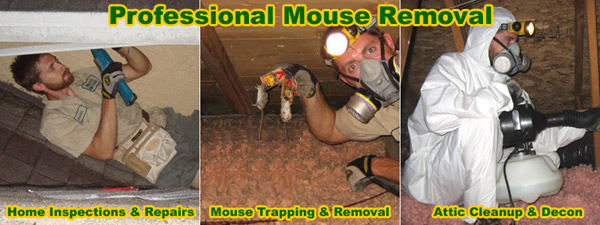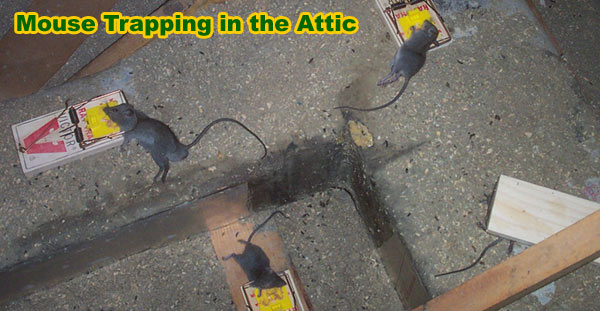How To Get Rid of Rodents
STEP 1) Find out how the mice are getting inside your house. There are holes outside, leading into the building. Vents, gaps in siding, areas where wires and pipes go into the house, roof lines, etc. Mice enter in these areas, then crawl up the walls and into the attic, which is an ideal nesting and hiding place. You will never get rid of all the mice permanently until you find out how they are getting inside.STEP 2) Seal every last entry point shut - anything larger than 1/4 inch. Use steel mesh or metal flashing, because these little rodents can chew though lesser repairs, such as mere caulking.
STEP 3) Trap and remove the mice. Set snap traps, at least ten of them, wherever you see mouse trails or droppings. I usually do this in the attic, where mice have left ample evidence with trails and mouse poop in the insulation.
STEP 4) Clean the attic space, if necessary, to get rid of germs, pathogens, and mouse odor that attracts new mice. This also helps prevent the growth of mold, which can happen with mouse urine and feces.

Why do rodents like to live in the attic? It's warm and dry and safe, that's why! They breed up there, they build rodent nests in the insulation, they poop, they pee, they store food. They make little tunnels and runways in the insulation.
Most people seem to notice the noises in the attic or walls at night. If it's a light pitter-patter, it's likely rodents. Sometimes the noises seem loud, if the rodents are running directly on the drywall. Some people report to me hearing noises like rolling nuts in the attic.
rodent in the attic can cause damage by chewing on electrical wires. They also spread diseases and odor. They often crawl down from the attic and into the house and kitchen, where they chew on various things, and get into the pantry and contaminate food.
How To Get Rid Of rodents In The Attic - If you know that you have rodents in the attic, then you may be thinking that it is the worst place for rodents. Some of those worries are warranted because you can tell why a mouse would think that the attic is perfect; it is small, dark, and there seems to be infinity of places where a mouse can hide. The attic is also a place that does not have much human traffic because it is not every day that you need something from your attic. But just because it is dark, small and has those hiding places does not mean that it is difficult to catch mice there. If you are asking “how do you get rid of mice in the attic” you will be surprised at how simple the answer is. Use traps with bait that mice will find irresistible, and more importantly, set these traps in the proper location, after you have sealed all of the mice's entry holes leading into the attic shut permanently. You just need to place the traps in the attic and leave them. Soon you will notice that the traps begin to work. The mice may be hiding in the attic, but they eventually have to leave their hiding place in order to feed. Peanut butter will get them in the trap within hours. Seeing mice in the attic may be tough, but trapping them is not.
How To Get Rid Of rodents In The Ceiling - There are many that might find that you have rodents in your ceiling. You can hear them scampering about. So, the question for you is how to get rid of mice in the ceiling? You have come to the right place to learn how to get rid of them. You have to lure them out. When you are looking at how to get rid of mice in the ceiling, some have set up traps up there and have put out peanut butter or cheese. That would be one way you can do this. This won’t kill them unless they just die in the traps, but at least you can get rid of them to some extent. Another idea for others who are looking at how to get rid of mice in the ceiling when you don’t want to use traps would be poison. They will go to die up there so you will have to go up to get rid of the dead mice, but that is a way to handle them as well. You don’t want them in your ceiling as they can do damage if they start chewing on your ceiling. So, try these things when you find those rodents up there.
Getting Rid Of Roof Rats - There are many places in your home but the one that is a bit more complex to solve is the rodents on the roof. The reason why the roof presents problems is that it gives the rodents a way out as well as a way in. It is also not the easiest place for you to get to. So there are a few things that you will need if the objective is getting rid of roof mice. Because getting the rodents from your roof can be a bit dangerous you should be really careful if you are going to give it a try. The best way to get mice from your roof is by far to use some sort of rodent poison. The reason for that is that there really is no good place to put a trap when you are on the roof. You will need to use a ladder to get there and once on the roof place the poison in places where they would be accessible to rodents, but try to hide it from other wild life. If you can place the poison somewhere that it will not get wet that will make it more likely that the rodents will find it.

Call Pest Arrest 281-374-7770

